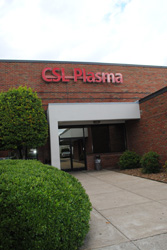Editorial
Front Page - Friday, November 5, 2010
Plasma donations provide economic benefit, aid fight against disease
Erica Tuggle
 Plasma donations are used in making biotherapies to treat illnesses like bleeding disorders, immune deficiencies, hereditary respiratory illness and in cardiac surgery, burn treatment and organ transplantation. CSL Plasma Services on Amnicola Highway offers locals an opportunity to donate for those in need and receive compensation for their time.
- Erica Tuggle
Plasma donations are used in making biotherapies to treat illnesses like bleeding disorders, immune deficiencies, hereditary respiratory illness and in cardiac surgery, burn treatment and organ transplantation. CSL Plasma Services on Amnicola Highway offers locals an opportunity to donate for those in need and receive compensation for their time.
- Erica Tuggle
Cold season has begun, and everyone knows how miserable it is to feel under the weather. Yet the feeling associated with a life-long illness is harder to imagine, and finding a way to help these individuals seems almost impossible. However, helping those with rare, life-threatening diseases locally and nationally begins with a simple visit to CSL Plasma Services on Amnicola Highway.
This local branch is one of many CSL Plasma Services has established across the nation to bring in plasma donations necessary to make the medicines that aid many serious diseases. CSL Plasma has been providing lifesaving services for about 20 years and is one of the largest plasma collection services in the world.
Chris Florentz, head of corporate communications for CSL, says the name of the process that takes place in the local plasma centers is called plasmaferesis. This process is similar to what happens during a blood donation, except that when the blood is drawn from the donor, it goes through equipment that separates the cellular part of the blood from the liquid part and then returns the cellular part back to the donor. The liquid part is kept and tested, and the protein content within it is used to make the different therapies for those in need.
After the plasma is donated, it undergoes extensive testing before being sent to CSL Bearing, CSL Plasma’s parent company. There, the plasma is used to make various drugs called biotherapies that help patients with bleeding disorders, immune deficiencies and inherited respiratory diseases.
Florentz says, “[CSL Bearing is] one of the few companies that makes these types of products for these folks without which they would not be able to have a good quality of life, for one thing, or in some cases it could be a life- threatening disease.”
The plasma from donations is also used in cardiac surgery, organ transplantation and burn treatment. What makes plasma so useful is the proteins within it that open the door to so many biotherapeutic products, and, in some ways, Florentz says, the technology with these elements is only beginning.
“There are many proteins in human plasma that we don’t even know what their role is in human biology,” he says. “Once we find those kinds of things out, there could be many more uses for plasma.”
When visiting a plasma donation center, the donor is asked to fill out a prescreening questionnaire and a medical screening form. These ask about conditions such as seizures, substance abuse, major surgery within the last six months, tattoos within the last 12 months and try to target medical conditions that would require a doctor’s care. The minimum criteria for a donor is a weight of at least 110 pounds, proof of identity, being between the ages of 18 and 59 and not having any infectious diseases. The emphasis on the sample’s safety and donor safety is very important, Florentz says, and the FDA regulates donation procedures.
“You need to keep in mind the folks that are receiving these products are those with serious diseases, so it is absolutely essential that we make sure the products they are receiving are not only high quality but completely safe products for their use,” he says. “You wouldn’t want someone with a rare serious disease to have any prospect of any other health issue because of a donation.”
The donation process itself takes a minimum of 45 minutes each time a person donates because of the process of plasmaferesis. As to the level of discomfort, Florentz says there is a range of opinion in donors just like there is for blood donations.
He says, “You could go into a plasma center and one person may be sitting back watching a movie, someone else might have their laptop out doing homework or playing a video game. Some people may find it somewhat uncomfortable and some people it doesn’t faze in the least.”
Donors are compensated for their time and, unlike donating blood, plasma can be donated up to two times a week. In addition to the monetary compensation, other incentives can be accrued through CSL’s reward system.
The economic impact of CSL’s donor locations is also significant in that the average plasma center pays sate and local taxes and employs and trains staffs of over 45 people, sometimes near 90 to 100 in the larger centers. The average annual payroll per plasma center is over 1.5 million. Donors at plasma centers are compensated almost $2 million per year, per plasma center, which usually returns to the local economy when donors spend money in the community, Florentz says.
He says, “There may be misconceptions out there about plasma and the process and the purposes it is used for. They are really very humanistic and wonderful reasons for the diseases we treat and all the other good things that ensue from the process, including the economic impact.”
|
|